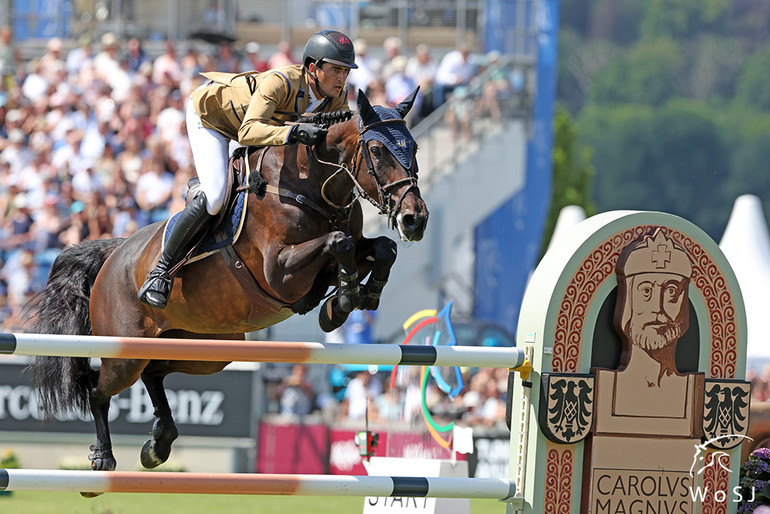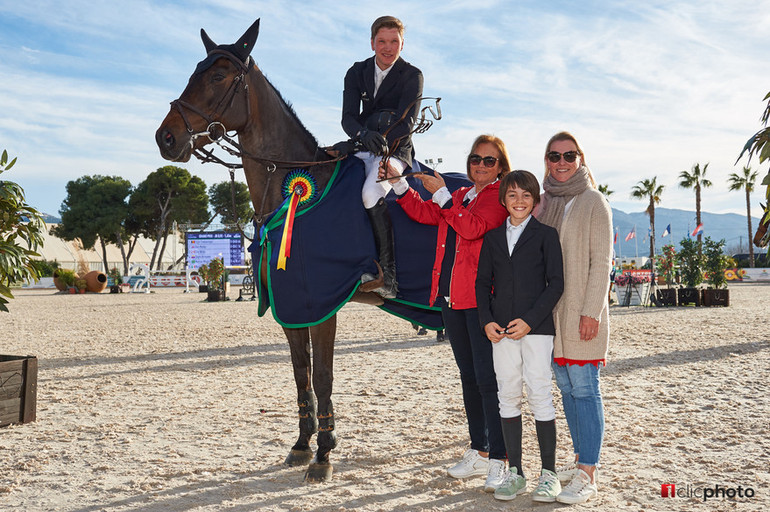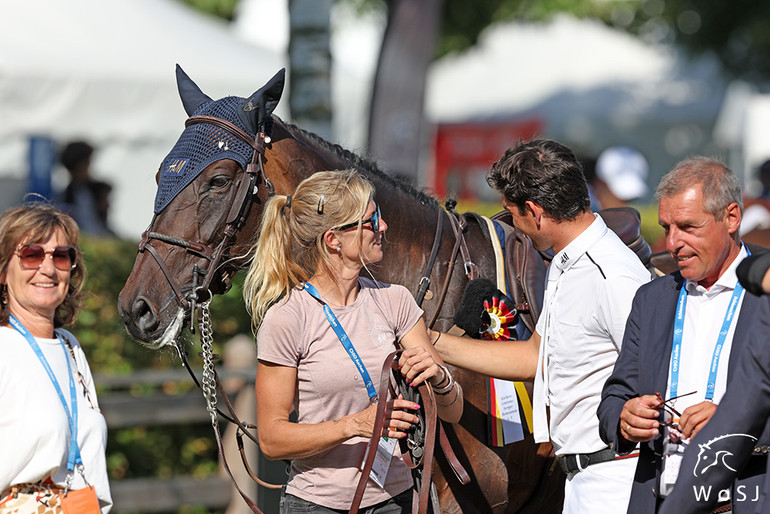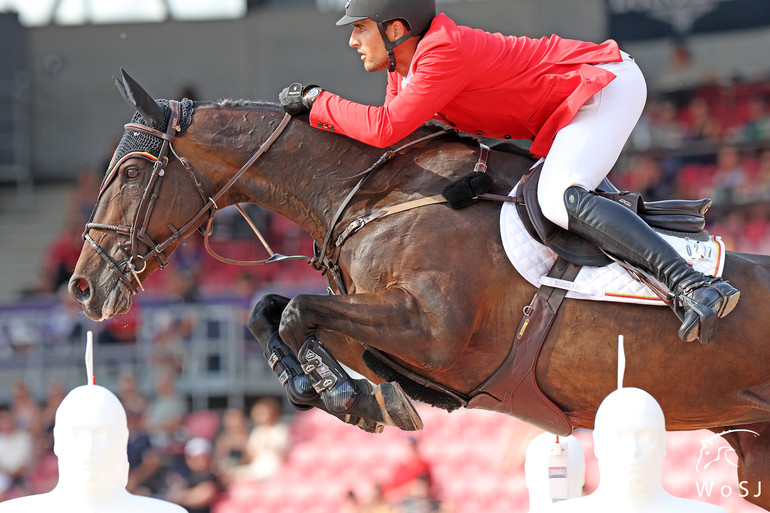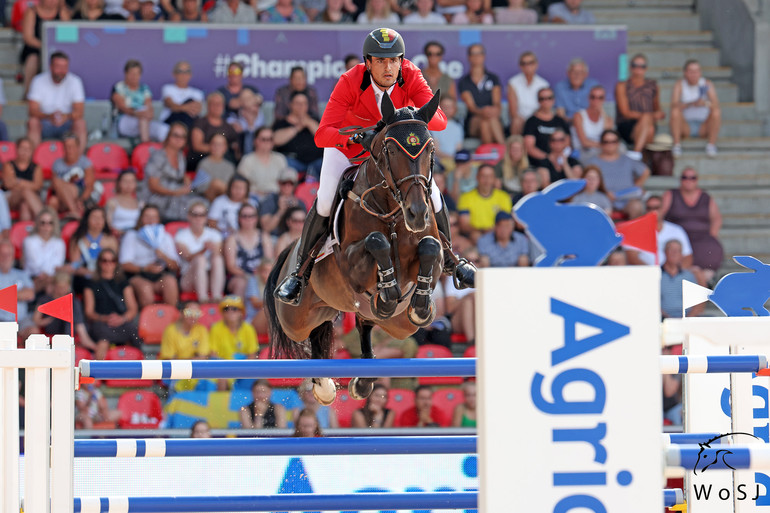Text © World of Showjumping
With Belgium’s Nicola Philippaerts in the saddle, the 12-year-old mare Katanga vh Dingeshof (Cardento x Tornado) has captured hearts worldwide. Last year, the pair was part of the bronze medal winning Belgian team at the European Championship in Riesenbeck, Germany, where they also finished 5th individually, and this year the two have continued to impress with an individual 8th place at the FEI Jumping World Championship 2022 in Herning, Denmark, and a 3rd place in the prestigious Rolex Grand Prix of Aachen earlier during the summer.
To learn more about Katanga’s journey to the top of the sport, World of Showjumping spoke to her breeder, Stal Dingeshof’s Mitch Vermeulen, Stijn Timmermann who works for the Philippaerts-family and who has played a big part in producing the talented but challenging mare, as well as Nicola Philippaerts who has found a great connection with this very special horse.
Small but feisty
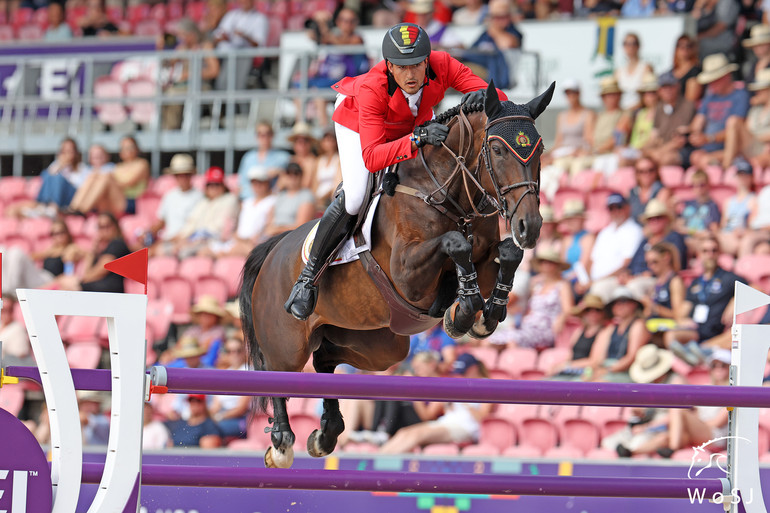
"You have to be lucky as a breeder to see your horses end up in the right place, with the right rider – and for them to stay there," Mitch Vermeulen says. "That is probably our luck with Katanga; Ludo really believed in her and Stijn and Nicola kept working with her.” Photo © Jenny Abrahamsson for World of Showjumping.
Tabelle Dingeshof, Katanga’s mother, seemed so talented as a young horse that she was not supposed to be used for breeding, but was meant to focus solely on the sport. “However, she unfortunately got injured in the field,” Mitch Vermeulen from Stal Dingeshof tells. “The year before Katanga was born, Tabelle had a foal by Indorado, but the foal did not survive. My father Jaak Vermeulen really wanted to use Indorado again, but for some reason we could not get him at that time. My father got tipped about Cardento; it seemed he could be a nice fit for our mare and after a background check, we decided to go for it.”
They did a lot of work to bring her to where she is now
“Katanga was not big when she was born, but she had a lot of blood,” Vermeulen recalls. “At the age of three, we tried to get her in foal, but we had no luck with that and afterwards she was saddle broken and my brother Kevin started to ride her. As she had a lot of blood, she was not easy to ride. When Katanga was six, Marjan Poukens took over the reins. In the beginning it did not go too well; the connection was not really there and Katanga was really hot. However, for some reason, everything seemed to change at a local young horse championship, and they started to do better and better. In the winter of her sixth year, Katanga jumped at Sentower Park and caught Ludo Philippaerts’ eye. When Ludo asked my father about her, he said he did not want to sell – but Ludo kept asking. A few weeks later, Ludo asked again – and my father set a price, and said they had to take her as she was, they could not try her. My father said he believed in the horse, and that Ludo would not regret buying her. To this day, when we see Ludo, he brings up this story – now he understands why they were not allowed to try her.”
“They did a lot of work to bring her to where she is now,” Vermeulen says about the team of riders at Philippaerts that have been a part of Katanga’s journey. “The problem you have, when you sell horses, is that sometimes good horses end up with amateurs even if they could do more – and then you never hear from those horses again. You have to be lucky as a breeder to see your horses end up in the right place, with the right rider – and for them to stay there. That is probably our luck with Katanga; Ludo really believed in her and Stijn and Nicola kept working with her.”
A complicated project
Stijn Timmermann, who works for the Philippaerts-family, got the ride on Katanga when the mare was eight. “Ludo had bought her when she was six, without trying,” Timmermann tells. “Antonia Andersson, who worked for the Philippaerts-family at the time, rode Katanga when she was seven, and when she left, Katanga was given to Thibault. However, she was too difficult to ride – she was basically unrideable – and after a while she was given to me. I still remember how one Saturday, I got a call and was asked to just sit on her one time to see how she was. I sat on her, only walked and trotted a little bit, and thought ‘this horse is impossible to ride’ – I saw no point in continuing with her.”
I sat on her, only walked and trotted a little bit, and thought ‘this horse is impossible to ride’
“However, I believe in giving every horse a chance,” Timmermann continues. “I think you should not give up too fast. Katanga deserved a chance, and I like special horses, especially mares. They are challenging, but if you get them on your side, they often give you more than a gelding or a stallion ever would. In the beginning I lunged Katanga for one month, just to get her to relax. Then I started to ride her a little bit after lunging, and step by step, it got better. Jan Simons helped me a lot with her, just to get the flatwork better. It was the beginning of May in 2018 when I got her, and I did only one show to see how she behaved in the ring, to get a proper overview of the whole horse. I jumped a 1.30m class with her and she just ran away with me; there was no steering. From the beginning of May to the beginning of October, I did not compete any more with her, I only did flatwork at home and jumped tiny fences.”
In October 2018, Timmermann took Katanga to a few small shows and jumped 1.30-1.35m classes, and in November they jumped a 1.40m class. “Then I took her to Moorsele to a national 1.45m Grand Prix and we were placed fifth,” Timmermann recalls. “That was a good result. With Katanga, if I did schooling rounds, it broke her jump a little bit. If I let her run and be herself, she was like a different horse and jumped much better. At the end of 2018, I jumped the Belgian indoor championship in Mechelen and we were fifth there, placed behind big names such as Niels Bruynseels, Dominique Hendrickx, Pieter Devos… Considering Katanga’s progress, that was a very good result.”
When you went to a show, she had the fighting spirit, she was naturally fast
The winter of 2018 was a turning point for Katanga. “I still remember an evening when me and Andre were training in the indoor, we jumped with Katanga and Ludo opened the window, asking how it was going with her. That day, I told him; ‘when this horse finds her rider, she can jump everything’. Until now, she is the only horse I have said this about. You could not see it on her, when you saw her jumping at home – but when you went to a show, she had the fighting spirit, she was naturally fast. When I took her to Oliva the following spring, we won the two-star Grand Prix. In our last week there we had one down in the three-star Grand Prix – and after that, Nicola took over the reins.”
The right mentality
“Katanga is very careful and her fighting spirit in the ring is unbelievable,” Timmermann says. “I think her mentality is her best quality. It is not that you say ‘wow’ when she does small jumps, but when she goes into the ring, she knows what she has to do."
You have to respect her and the way she is
"When she was third in the Rolex Grand Prix of Aachen, they were in the warm-up with Martin Fuchs’ Leone Jei, and that one jumps with a lot of air – and then after him, came Katanga. Then you really see the difference. It is easy to judge from the side, and if you tried to make her look better, go in a more classical way, you take her jump away – you have to respect her and the way she is. And does every horse need to be classical and always look perfect? I don’t know. I believe that for any horse, having the right match with their rider is important. I think Nicola can handle Katanga very well, but I do think she is a horse that can give a lot to many riders; you just need to have confidence in her and accept her as she is. It makes me proud to have been a small part of her journey.”
Proved where she belongs
Nicola Philippaerts took over the reins on Katanga when the mare was nine. “During the first months, I struggled; she was really special and I had to adapt quite a bit to her,” he recalls. “The quality and scope was there, but she was so difficult to ride. I took her to a few training shows and the first time I thought she felt very good was in Eindhoven, where she was clear in the Grand Prix and had one down in the jump-off. She jumped really good, even though she was still difficult. However, that was the moment where I felt we were on the right track. A month later she was third in the five-star Grand Prix in Lausanne, but then I broke my shoulder, so she got a few months off. Once I got back in the saddle, she has actually been my number one horse.”
Katanga’s best feature is her mentality; she is a real fighter, she has so much scope and quality
“Katanga’s best feature is her mentality; she is a real fighter, she has so much scope and quality,” Philippaerts continues. “She has such a strong personality; it makes her good. If you see her in the box, she is not big, she is a small horse, but with the mentality she has, she can jump everything – and she has proven that by now. The reason I struggled with her in the beginning was all about confidence; I had to get to trust her. Sometimes, she can still block a little, but you just have to trust her and know that she will jump. I feel like the harder the approach to the fence is, the better she jumps – it took me some time to understand that. Now, I try to give her confidence and time to see the fences, and trust that she can jump anything – she has been like this all her life.”
“Actually, I think that has been our luck,” Philippaerts says about the fact that they bought Katanga without trying her. “If we had tried her, we would perhaps not have bought her. She jumped good, she was careful, the results were always very good, but she has always been special to ride. Stijn has done a great job with her. She is a fantastic horse and she was proven herself in the last years. For sure I don’t want to show her too much anymore, I want to save her for the biggest shows and championships. I hope with all my heart that she stays sound so we can keep going on the highest level of the sport.”
No reproduction without written permission, copyright © World of Showjumping.com



